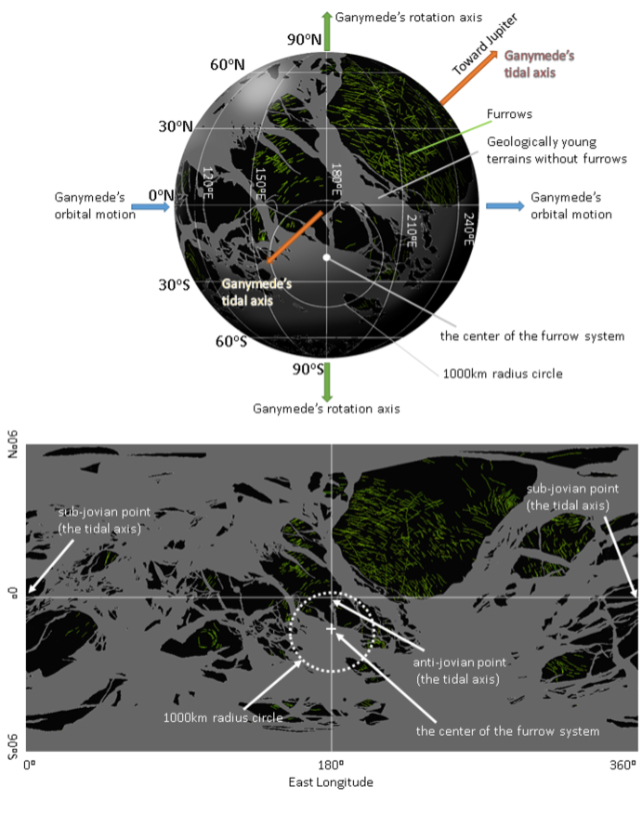Ganymede is a moon that wears its scars with the resignation of an old veteran. Its furrowed crust speaks of harder times, its tilt like a limp from an injury it’d prefer to never speak of again.
Comparing its features with known assaults on other planets, Kobe University planetologist Naoyuki Hirata has continued to deduce the fallout from one of the biggest impacts to ever leave its mark on the outer Solar System.
At more than 5,000 kilometers (more than 3,000 miles) across, Ganymede rivals Mercury in size, taking first prize for the Solar System’s largest natural satellite. The monolith has been a notable landmark in the heavens ever since renowned astronomer Galileo Galilei glimpsed it through his telescope one fateful evening in 1610.
Yet for all of its size and familiarity, the far distant Ganymede has hidden its secrets well. It wasn’t until the Voyager missions provided a close-up view of the Jovian moon system that astronomers could scrutinize its craters and canyons for clues on the object’s tumultuous history.
Of particular interest were a number of long grooves and ridges spread across a significant part of the moon’s surface.
Given the lines’ antiquity beneath newer layers of rock, and their concentric nature, they were quickly assumed to be the result of a collision when the Solar System was still learning to regulate its emotions.
To Hirata, the grooves were a calling.
“The Jupiter moons Io, Europa, Ganymede, and Callisto all have interesting individual characteristics, but the one that caught my attention was these furrows on Ganymede,” says Hirata.
“We know that this feature was created by an asteroid impact about 4 billion years ago, but we were unsure how big this impact was and what effect it had on the moon.”
Several years ago, Hirata and his colleagues ran a series of simulations to approximate the size and velocity of the meteorite behind the collision. They determined it was likely to be an asteroid some 150 kilometers across that smacked into the icy surface at roughly 20 kilometers a second and caused it to ripple and splash.
Given the dinosaur-murdering lump of space rock that gave Earth a black eye 66 million years ago was around 10 to 15 kilometers across, it’s easy to appreciate this was no small crater.
A follow-up study using two different planetary models now proposes the redistribution of all of that material in the wake of the collision would have been sufficient to reorient the moon’s axis.

Such is the chaos of planet formation, there is hardly an object in the entire Solar System that hasn’t been set spinning, wobbling, or tilting askew by titanic feats of physics.
Uranus may have been dragged over by a runaway moon. Our own Moon was probably the result of a merger that pressed reset on Earth’s formation. Pluto’s lopsidedness is thought to be the result of feedback between accumulating ice and its satellite’s tidal forces.
Like Pluto with its moon Charon, Ganymede is tidally locked with its host, forced by gravity to forever present one face to the cloud tops below by virtue of the intense gravitational pull between its and Jupiter’s masses putting the brakes on its rotation.
Perhaps a little too coincidentally, Ganymede’s furrows happen to converge roughly on a spot aligning neatly with the moon’s face exactly opposite Jupiter, as if it is an eye cursed now to stare out into space away from its host planet.
Hirata’s models provide strong evidence that a mere thousand years after the massive asteroid slammed into the moon‘s surface, subtle changes in its mass as ejected rock and ice rained back down caused the body to rotate and lock into a new position.
Questions remain over how other factors over time may have affected the distribution of mass and therefore its gravitational effects. With so much of Ganymede yet to be imaged in high resolution, there are also bound to be fresh discussions over how the liquid oceans below may affect the thick crust above.
Yet the ancient smackdown could inform future models on the formation of the Jovian satellites, and how to better interpret various furrows and scars to gauge the distribution of materials and energy throughout the Solar System’s history.
“The giant impact must have had a significant impact on the early evolution of Ganymede, but the thermal and structural effects of the impact on the interior of Ganymede have not yet been investigated at all,” says Hirata.
“I believe that further research applying the internal evolution of ice moons could be carried out next.”
This research was published in Scientific Reports.





